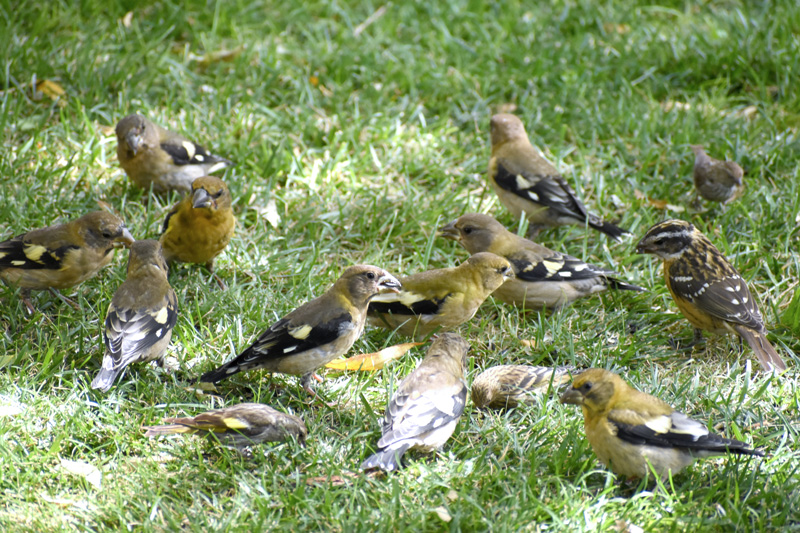Evening Grosbeaks
Evening Grosbeaks make their home around northern and middle New Mexico, mostly following the distribution of budworms, a needle-eating insect and preferred snack for Grosbeaks during summer. The name “Evening” refers to a mistaken belief of New England colonists upon their first encounter with the bird in evenings. In fact, Grosbeaks are active all day long, and head home to their nests only after nightfall.

Grosbeaks will visit reliable seed feeders year-round—key word is “reliable.” Going even just a few days with empty feeders is reason enough for these persnickety finches to pack up and search elsewhere for food. Evening Grosbeaks aren’t especially territorial since their food sources are readily available. It’s common to see them travel in flocks of up to 20 or so, and they attract smaller birds who pick over their leftover seeds. With a sizable flock, you can easily go through a pound of seed a day feeding these cuties. Black oil sunflower seeds are a standby for these birds, especially in winter when insect populations decline. They prefer platform feeders but will forage along the ground for fallen seeds from feeders, making them convenient janitors for messier eaters like Magpies and Stellar Jays. Grosbeaks use their large, shovel-like beaks to roll a sunflower seed over in their mouth until the pointed end is facing their throat and the broad side lays along the sharp edge of their beak, allowing them to shear it lengthwise. With a few more dexterous movements the husk is released and the seed is digested.
Planting fruit-bearing shrubs or trees can also attract Grosbeaks to your yard. They make great garden companions due to their ability to hunt out budworms and caterpillars and can alert us with early warning sign of infestations.
You’ll easily notice male Evening Grosbeaks from their flashy feathers: bright white spots on black wings, a golden breast, and an unmistakable yellow scowl across their eyebrows. Females are smaller and have more muted colors, with a splash of yellow around their neck, but both sexes share a gray-green bill which sheds its outer layer in spring and takes on a more bluish hue. Couples tend to be monogamous during their breeding season, but if food is widely available males may choose to wander around. Females build a cup-shaped nest out of twigs, moss, and pine needles and produce two to five eggs. It’s not uncommon for males to feed females during nesting, and both parents share the work of feeding nestlings.
Grosbeaks are one of 57 species of birds in New Mexico that are imminently threatened by rising global temperatures, according to the Cornell Lab of Ornithology. Nestlings can’t survive in high temperatures. Without a reliable food source, they may abandon the contiguous United States and move toward Canada. Project FeederWatch is a volunteer-driven survey of bird populations operated by the Cornell Lab. From 1989 to 2006, FeederWatch reported a 50% decline in sightings of the Evening Grosbeak and a 27% decline in flock size. The exact cause of this population decline is unknown to scientists, though increased extreme temperatures and pesticide use are known to be contributing factors.
Local birdwatchers can submit any sightings of Evening Grosbeaks to eBird using the eBird app or by going online to www.ebird.org. To participate in FeederWatch, download their app or go to www.feederwatch.org and sign up to request a kit. The project will take place during November to April and you can sign up to participate now.
Author
-

Bryce Flanagan moved from Sacramento, CA to Taos County in 2016, and has lived in Questa for two years. He's passionate about the unique and beautiful wildlife of our state and is a regular contributor to the Questa Del Rio News.
View all posts


